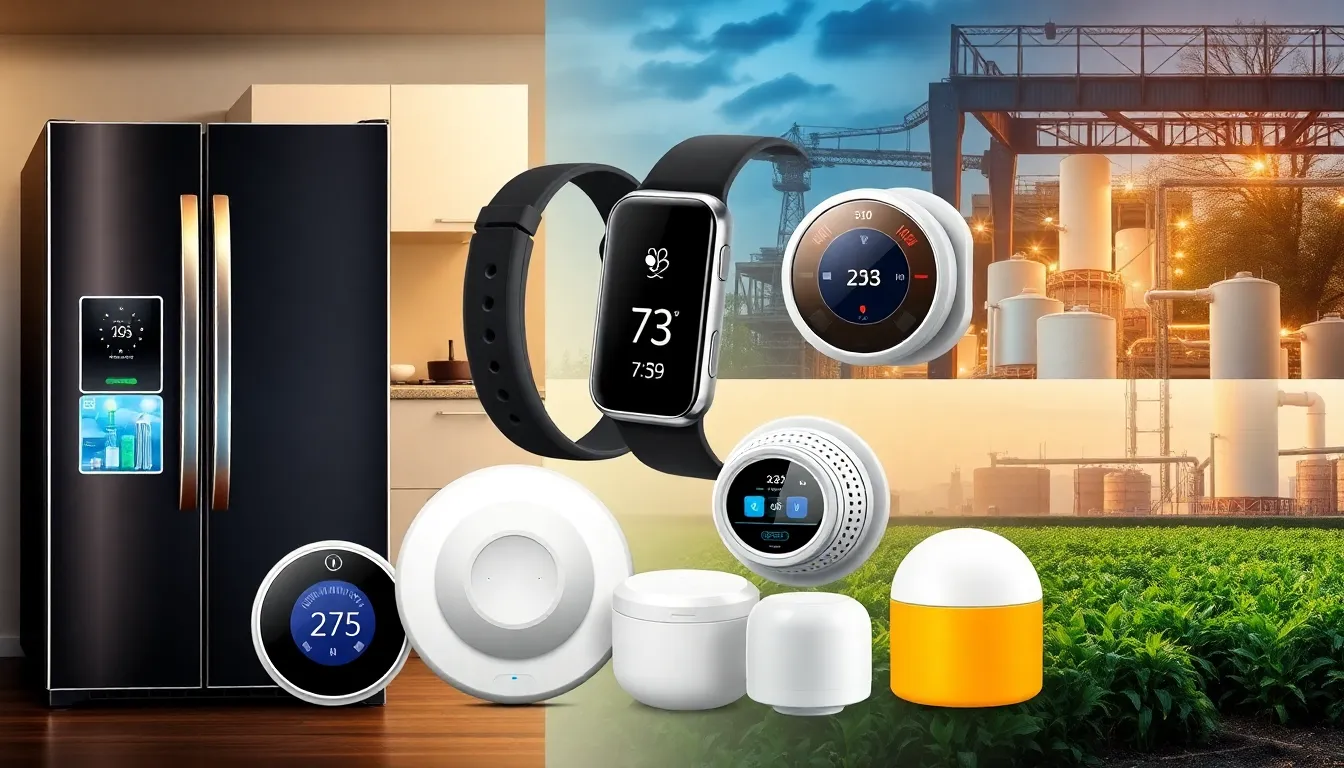Table of Contents
ToggleImagine a world where your toaster chats with your fridge while your thermostat negotiates with your coffee maker about the perfect brew time. Welcome to the Internet of Things (IoT), where everyday devices transform into smart companions that not only make life easier but also a bit more entertaining.
From smart homes to wearable tech, IoT devices are revolutionizing how people interact with the world around them. They’re not just gadgets; they’re the quirky sidekicks in the story of modern living. With endless possibilities, these devices are here to simplify tasks, enhance convenience, and maybe even crack a joke or two along the way. Dive into the fascinating realm of IoT and discover how these clever contraptions are reshaping daily life, one laugh and one smart decision at a time.
Overview of Internet of Things Devices
Internet of Things devices encompass a vast array of smart technologies designed to enhance daily routines. These devices include smart thermostats, which regulate home temperatures based on user preferences, and smart security systems that enable remote monitoring for peace of mind.
Wearables like fitness trackers provide real-time health data, while smart speakers offer voice-activated assistance. Such technologies keep users connected and informed.
Household gadgets also play a significant role in the IoT ecosystem. Smart refrigerators can track inventory and suggest recipes based on available ingredients. Meanwhile, connected lighting systems allow users to adjust brightness and color through a mobile app.
Industrial applications of IoT devices drive efficiency in manufacturing. For instance, sensors monitor equipment conditions, predicting maintenance needs and minimizing downtime. This proactive approach enhances productivity and safety in various sectors.
Healthcare experiences transformation through IoT devices as well. Remote patient monitoring improves care by providing accurate health data to professionals. Telehealth services further expand accessibility for patients and healthcare providers.
In agriculture, IoT devices facilitate precision farming, with soil sensors and drones monitoring crop conditions to optimize yields. Smart irrigation systems respond to real-time weather data, conserving water resources and improving sustainability.
Industry analysts project the adoption of IoT devices to grow exponentially in the coming years. Innovations continue to emerge, shaping a connected world where convenience and efficiency integrate seamlessly into everyday life.
Types of Internet of Things Devices

IoT devices significantly enhance how individuals and industries interact with technology. Various categories exist, serving diverse needs.
Consumer IoT Devices
Smart home appliances fall under consumer IoT devices. These include smart refrigerators that manage food inventory while suggesting recipes. Smart thermostats learn user preferences to optimize heating and cooling, improving energy efficiency. Wearables, like fitness trackers, monitor health metrics, allowing users to track activity levels. Smart security systems also enter the consumer space, providing remote monitoring and alerts for enhanced safety. Connected lighting systems let users adjust their environment through mobile apps, creating a personalized atmosphere.
Industrial IoT Devices
Industrial IoT devices focus on enhancing operational efficiency. Sensors monitor equipment conditions, predicting maintenance needs and reducing downtime. Smart factory solutions automate processes, enhancing productivity across various sectors. In agriculture, IoT technologies like soil sensors optimize irrigation and improve crop yields. Fleet management systems track vehicle performance, ensuring timely deliveries. Remote monitoring in healthcare involves devices that manage patient data from afar, assisting healthcare professionals in delivering timely interventions.
Benefits of Internet of Things Devices
Internet of Things devices offer numerous advantages that enhance both personal and professional environments.
Improved Efficiency
IoT devices streamline operations in various sectors. Smart thermostats adjust heating and cooling based on occupancy, saving energy while maximizing comfort. Retailers use connected inventory systems for real-time stock management, reducing waste and preventing product shortages. Predictive maintenance technologies in manufacturing increase operational uptime by forecasting equipment failures. Additionally, energy management tools optimize usage, reducing costs and environmental impact. These devices contribute significantly to enhanced productivity, allowing users to focus on core tasks instead of routine checks.
Enhanced Connectivity
Connectivity represents a key benefit of IoT devices. Smart home solutions enable seamless integration across various appliances, allowing users to control functions via mobile apps. Health monitoring wearables share data with healthcare providers instantly, fostering proactive medical interventions. Moreover, industrial IoT implementations create robust networks that connect machinery with centralized management systems. Enhanced data flows lead to informed decision-making, identifying inefficiencies and improving workflows. This interconnectedness creates synergies that transform not only home life but also entire industries into more responsive and agile entities.
Challenges and Concerns
The rise of Internet of Things (IoT) devices introduces several challenges and concerns that must be addressed to ensure their safe and effective use.
Security Issues
Security issues pose significant risks for IoT devices. Vulnerabilities in software and hardware can create openings for cyberattacks. Hackers can exploit weak passwords or insecure networks, gaining unauthorized access. Smart cameras and home assistants frequently come under scrutiny for their potential to be compromised. Effective security measures are essential, including robust encryption and regular firmware updates, to mitigate these risks. Consumers must remain vigilant, given that the prevalence of attacks continues to rise. Effective awareness training and proper device configuration play vital roles in enhancing security.
Data Privacy
Data privacy remains a critical concern in the IoT landscape. Devices collect vast amounts of personal information, often without users’ explicit knowledge. This data can include everything from usage patterns to health metrics. Unauthorized data sharing poses threats to user privacy. Regulations like the General Data Protection Regulation (GDPR) address some of these concerns, mandating greater transparency in data handling practices. Companies must prioritize data protection strategies that safeguard user information. Opt-in models for data sharing can empower consumers, ensuring they have control over their personal data and its usage.
Future Trends in Internet of Things Devices
Emerging trends within the Internet of Things (IoT) landscape signify a transformative phase for devices. Increased integration of artificial intelligence enhances the functionality of IoT devices, enabling them to learn user preferences over time. Smart home devices now feature advanced analytics, providing users tailored recommendations to optimize energy use or improve security.
5G technology plays a pivotal role in driving IoT device innovation. High-speed connectivity supports a multitude of devices communicating simultaneously, resulting in real-time data processing. Smart cities benefit from this rapid connectivity, utilizing IoT devices to manage traffic flow and improve public safety.
Additionally, sustainability drives IoT advancements, prompting manufacturers to develop eco-friendly devices. Energy-efficient appliances reduce overall consumption while connected sensors monitor environmental impacts. This eco-conscious approach attracts consumers increasingly concerned about environmental issues.
Interoperability gains traction as various devices and platforms strive to work seamlessly together. Standards for compatibility help create cohesive ecosystems, allowing users to control disparate devices through a single interface. Enhanced user experience fosters further adoption of smart solutions.
Moreover, the healthcare sector experiences a surge in remote monitoring capabilities. New IoT wearables track vital signs and health metrics, ensuring timely interventions. Patients and providers benefit from increased accessibility, making healthcare more efficient.
Security measures evolve in response to rising IoT device deployment. Advanced encryption and continuous security updates are vital to combat cyber threats. Regulatory measures also shape the future landscape, emphasizing data privacy and the responsible collection of personal information.
Ultimately, trends in IoT devices highlight innovation across various sectors, driven by connectivity, efficiency, and an ever-increasing emphasis on user safety.
The evolution of Internet of Things devices is reshaping how people interact with technology in their daily lives. With the promise of enhanced convenience and efficiency these devices are becoming integral to modern living. As innovations continue to emerge the potential for smarter homes and workplaces grows exponentially.
However the importance of addressing security and privacy concerns cannot be overstated. As individuals embrace these advancements it’s crucial to remain vigilant about data protection. The future of IoT holds exciting possibilities that blend technology with user needs while fostering a more connected and efficient world.







